 |
 |
 |
 |
 |
 |
| |
 |
|
 |
 |
 |
  |
  |
 |
 |
 |
 |
|
|
 |
|
 |
 |
 |
OPERA |
 |
|
 |
|
 |
 |
 |
| |
 |
| 
 |
Villa Noailles
|
|
 |
 |
 |
 |
PROGETTISTA |
 |
|
|
 |
|
 |
 |
 |
| |
 |
|
 |
 |
 |
 |
DESCRIZIONE |
 |
|
|
 |
|
 |
 |
 |
| A life as patrons |
 |
|
 |
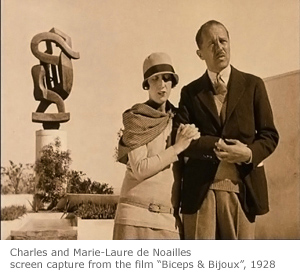 Marie-Laure Bischoffsheim (1902- 1970) was only two years old when her father, Maurice, passed away, leaving her to inherit a considerable family wealth, along with an outstanding collection of paintings belonging to her grandparents. Two individuals in particular had a marked influence on her youth: her grandmother, Laure de Chevigné, whose modern attitude inspired Proust's Duchess of Guermantes, and a young poet, called Jean Cocteau, who was to be instrumental in introducing her to the avant-garde of pictorial, musical, and literary arts. Marie-Laure Bischoffsheim (1902- 1970) was only two years old when her father, Maurice, passed away, leaving her to inherit a considerable family wealth, along with an outstanding collection of paintings belonging to her grandparents. Two individuals in particular had a marked influence on her youth: her grandmother, Laure de Chevigné, whose modern attitude inspired Proust's Duchess of Guermantes, and a young poet, called Jean Cocteau, who was to be instrumental in introducing her to the avant-garde of pictorial, musical, and literary arts.
Following the Great War, Charles de Noailles (1892-1981) regularly attended the salons of the count de Beaumont, as did Marie-Laure. The de Noailles lineage, which may be traced back to the Crusades, is scattered with well-known figures, throughout the different periods. Charles de Noailles was to take particular interest in the contemporary decorative arts, architecture, and horticulture. It was upon these shared passions that their relationship was to form, and in February of 1923, they married in the Provençal town of Grasse.
They perused through the salons and exhibitions of 1925, acquiring furniture and paintings, meeting designers, and consequently, re-furnished their private residence on the place des États-Unis, Paris. Charles and Marie-Laure de Noailles rapidly developed their own style and, after only a few years, had already made an impression in both the press and artistic circles as two of the most active and interesting benefactors of the second half of the 1920s. The start of the next decade was to see even more ambitious projects, but equally a slowing down of their support, following the scandal provoked by the film, L'Âge d’Or (Age of Gold). The viscount's patronage continued, but was now more discrete in nature. Marie-Laure de Noailles, on the other hand, stepped out from her usual reserve and started to write, to paint, and received more artists and writers in her home than ever before.
If the Second World War was to mark the end of an era, then Charles and Marie-Laure de Noailles emerged from it with their aura intact. The viscount now seemed more interested in his gardens and in his house in Grasse, but he continued to watch over those projects which were close to his heart. Marie-Laure, however, followed with a passion the artistic trends of her time and continued to receive her artist and literary friends, in both Paris and in Hyères. Marie- Laure de Noailles supported many young artists up until her death, in 1970. |
|
 |
 |
 |
|
 |
|
| Architecture |
 |
|
 |
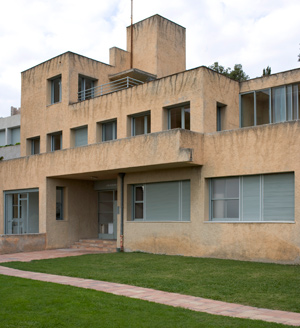 The villa Noailles, built between 1924 and 1932, is one of the most revealing examples of the new techniques developed by modern architects in the Interwar period, in France. The project was entrusted to the architect Robert Mallet-Stevens, for whom this was to be his first completed commission. He initially proposed a plan for a vast building on two floors, overlooked by a belvedere. A second plan, more compact, eventually satisfied the requirements of Charles de Noailles, who wished above all for a practical building: "a small, interesting home to live in". Consisting of five bedrooms, a living room, and a dining room, the project seemed modest for clients such as the viscount and his wife. It fulfilled the period's requirements for healthy living, as each room had its own terrace and bathroom. All of the living areas faced due South, whilst all of the corridors were pushed towards the North. If at first the cubic shapes were without a décor, the building was still subject to the relationship between its proportions and rhythms. The interaction between full and empty spaces, the repetitions of forms, and the cantilevered awnings, all evoked an affinity with the Neoplasticism of the Dutch De Stijl group. The villa Noailles, built between 1924 and 1932, is one of the most revealing examples of the new techniques developed by modern architects in the Interwar period, in France. The project was entrusted to the architect Robert Mallet-Stevens, for whom this was to be his first completed commission. He initially proposed a plan for a vast building on two floors, overlooked by a belvedere. A second plan, more compact, eventually satisfied the requirements of Charles de Noailles, who wished above all for a practical building: "a small, interesting home to live in". Consisting of five bedrooms, a living room, and a dining room, the project seemed modest for clients such as the viscount and his wife. It fulfilled the period's requirements for healthy living, as each room had its own terrace and bathroom. All of the living areas faced due South, whilst all of the corridors were pushed towards the North. If at first the cubic shapes were without a décor, the building was still subject to the relationship between its proportions and rhythms. The interaction between full and empty spaces, the repetitions of forms, and the cantilevered awnings, all evoked an affinity with the Neoplasticism of the Dutch De Stijl group.
Despite the architect's wishes, when construction began in April of 1924, it was to exclude the reinforced concrete he had requested, as the local builders had not yet mastered its use. During construction work, the viscount decided to abandon the plan for a belvedere – much to the architect's dismay – , and instead asked him to design a wall pierced with great picture windows, to enclose the courtyard facing the villa.
Pleased with the result, they ceaselessly extended and transformed the building, up until 1932, extensively modifying the initial plan. Thus, an annexe consisting of four bedrooms was added in 1925, followed by a second annexe in 1926, attached to the first by means of a covered staircase. The following year, Mallet-Stevens designed a surprising, three dimensional décor for the new Pink living room. During the same period, the construction of a sizeable pool room was undertaken, this time partially constructed out of reinforced concrete, comprising of a large pool and a ceiling made of glass bricks, forming a stunning geometrical composition. The south façade of the pool room, with its four, monumental, sliding picture windows, granted supremacy to all that was made of glass, over everything else. A gymnasium, followed by a squash court, completed the sports facilities. With fifteen master bedrooms and guest houses, the villa as a whole covers almost 1800m2 of living space. |
|
 |
 |
 |
|
 |
|
| Interior design |
 |
|
 |
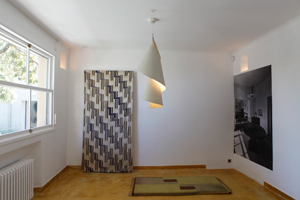 The commissioning of a modern residence led Charles and Marie-Laure de Noailles to design an interior in accordance with this new architecture. The majority of the chosen designers were recommended by the architect Robert Mallet-Stevens, who was also responsable for designing the pool room deckchairs. The interior décor consisted of both specific commissions for individual rooms – such as the dining room, which was entrusted to Djo-Bourgeois as early as 1924 –, as well as a concerted programme of acquisitions. The commissioning of a modern residence led Charles and Marie-Laure de Noailles to design an interior in accordance with this new architecture. The majority of the chosen designers were recommended by the architect Robert Mallet-Stevens, who was also responsable for designing the pool room deckchairs. The interior décor consisted of both specific commissions for individual rooms – such as the dining room, which was entrusted to Djo-Bourgeois as early as 1924 –, as well as a concerted programme of acquisitions.
The furnishing of their villa occurred over a number of stages, as the couple were to accord themselves the time necessary for visiting the exhibitions, in order to find the designs they wished to incorporate. For example, a dial, designed by Francis Jourdain and discovered at the Autumn Exhibition of 1922, served as the inspiration for the villa's clocks. The International Exhibition of Decorative, Industrial, and Modern Arts of 1925, was to reveal itself as a genuine source of inspiration, leading to the acquisition of a "hanging bed" by Pierre Chareau, stools by M.me Klotz, and "simultaneous" fabrics by Sonia Delaunay, which were literally transposed to their villa in Hyères.
The villa was home to both extremely refined designs, such as a rug by Eileen Gray for Marie-Laure's bedroom, or a folding games table by Charlotte Perriand, as well as more industrial furnishings, manufactured by firms such as Smith & Co (for the armchairs) and Ronéo (for the sheet metal tables and cabinets). Chareau's inventiveness consorted with the elegance of Dominique. Louis Barillet was to create the stained glass ceiling and the Martel brothers designed a polyhedral mirror. The foldaway ironworks, designed by Jean Prouvé for the open-air bedroom, housed the furniture constructed of metallic tubes, designed by Marcel Breuer.
Two particular commissions, entrusted to Dutch artists, were notable for their radical nature. In 1925, the artist and theoretician, Théo van Doesburg, was assigned with the composition of a geometric mural for the flower room and the architect Sybold van Ravesteyn was to create the entire design for the guest bedroom on the second floor. The French designer, Djo-Bourgeois, was often sought, particularly in 1926, with the extension of the dining room and the creation of four further bedrooms with fitted furniture. He was also to design an ingenious and colourful bar for the vaulted rooms in the annexe. |
|
 |
 |
 |
|
 |
|
| Artists |
 |
|
 |
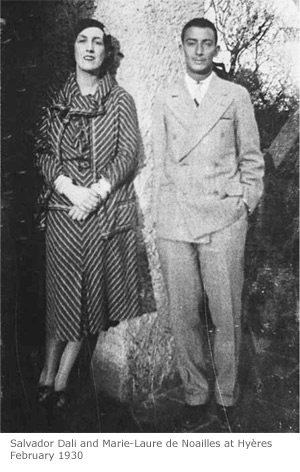 Charles and Marie-Laure de Noailles were patrons with a keen interest in artistic trends, thanks to the advice they received from Cocteau, Zervos, Rivière, and Leiris, as well as their attendance at some of the best galleries and publishers. As both collectors and commissioners, they offered their support to certain artists through the regular acquisition of works, or by offering them a monthly revenue along with other benefactors (such as the Zodiac Group), as was the case for Dali and Balthus. They frequently provided support that was not only remarkable, but also selfless: the viscount was to act as guarantor for the acquisition of Balthus's home and Marie-Laure donated a Zil to César, allowing him to undertake his first 'Compression' of a motor car. Charles and Marie-Laure de Noailles were patrons with a keen interest in artistic trends, thanks to the advice they received from Cocteau, Zervos, Rivière, and Leiris, as well as their attendance at some of the best galleries and publishers. As both collectors and commissioners, they offered their support to certain artists through the regular acquisition of works, or by offering them a monthly revenue along with other benefactors (such as the Zodiac Group), as was the case for Dali and Balthus. They frequently provided support that was not only remarkable, but also selfless: the viscount was to act as guarantor for the acquisition of Balthus's home and Marie-Laure donated a Zil to César, allowing him to undertake his first 'Compression' of a motor car.
Whilst their taste, at least initially, encompassed established artists, Cubists, and members of the Paris school, such as Chagall, Braque, Lipchitz, Gris, Léger, Derain, de Chirico, and Picasso, the arrival of Surrealism in the 1930s offered a new direction for both their collection and their patronage. Charles and Marie-Laure de Noailles acquired numerous works by Miro, Tanguy, Masson, Klee, Ernst, and Dali, as well as works by young emerging artists such as Nicholson, Toyen, and Styrsky. Their attendance at some of the key exhibitions of the period resulted in a number of major acquisitions. Hence, at the exhibition l'Art d'Aujourd'hui (Art Today) in December of 1925, they bought a work by Mondrian, making them one of the painter's rare clients in France. Brancusi was exhibiting a Bird in Space at this exhibition and the couple asked him to examine creating a monumental example for their villa. Lipchitz received his first commission for a monumental cast bronze sculpture from the viscount and his wife, who also placed numerous commissions from Laurens. They discovered Alberto Giacometti early on in his career, in 1929, following one of his very first exhibitions.
A lengthy series of portraits of Marie-Laure de Noailles, initiated by a sketch by Picasso in 1921, illustrates her lifelong personal relationship with artists such as Dora Maar, Bérard, Balthus, Giacometti, Fenosa, and Valentine Hugo. She also posed in front of the lenses of some of the greatest photographers of the time: Horst, Hoyningen-Huene, Durst, Beaton, Doisneau, Brassaï, Rogi André, Chadourne, Maywald, and of course Man Ray, who created at least ten different series with her portrait as its subject. |
|
 |
 |
 |
|
 |
|
| Litterature |
 |
|
 |
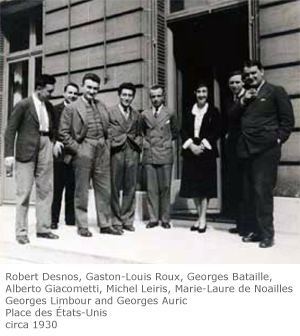 Charles and Marie-Laure de Noailles had numerous friendships in literary circles, amongst which one might mention writers such as Jean Cocteau – a childhood friend of Marie-Laure's –, Marcel Jouhandeau, Aldous Huxley, François Mauriac, René Char – from whom they were to acquire the manuscript for Marteau sans maître (The hammer without a master) – Georges Hugnet, and André Pieyre de Mandiargues. Then there were editors, such as André Gide, Jean Schlumberger, and Jean Paulhan – with whom Charles de Noailles was to correspond for over thirty years –, who were key figures at the NRF (New French Review) periodical and the publishers Gallimard, as well as Marcel Raval, publisher and director of the periodical Les Feuilles libres. All of these friendships resulted in Charles and Marie-Laure de Noailles making new acquaintances and frequenting new schools of thought and writing. Charles and Marie-Laure de Noailles had numerous friendships in literary circles, amongst which one might mention writers such as Jean Cocteau – a childhood friend of Marie-Laure's –, Marcel Jouhandeau, Aldous Huxley, François Mauriac, René Char – from whom they were to acquire the manuscript for Marteau sans maître (The hammer without a master) – Georges Hugnet, and André Pieyre de Mandiargues. Then there were editors, such as André Gide, Jean Schlumberger, and Jean Paulhan – with whom Charles de Noailles was to correspond for over thirty years –, who were key figures at the NRF (New French Review) periodical and the publishers Gallimard, as well as Marcel Raval, publisher and director of the periodical Les Feuilles libres. All of these friendships resulted in Charles and Marie-Laure de Noailles making new acquaintances and frequenting new schools of thought and writing.
This support covered the full gamut of Surrealism: André Breton, Paul Eluard, or even René Crevel, who was also a close friend. However, it was their friendship with the museologist Georges- Henri Rivière which contributed most in surrounding the couple with other intellectuals and alternative philosophies of thought. Rivière was the kingpin behind the projects of the ethnographic Mission of Dakar-Djibouti, in 1931, as well as the creation, in 1937, of the Museé de l’Homme (Museum of Man), with which Charles de Noailles was actively involved. Without taking sides, the couple also supported the intellectual revival which emerged from the periodical, Documents, created in April of 1929, by acquiring manuscripts by writers such as Michel Leiris, Robert Desnos, Georges Limbour, and Georges Bataille (in particular that of Story of the Eye) for their collection. Embodying a form of resistance to Surrealism – as conceived of by Breton –, Documents was to play an important role in the evolution of contemporary thought, positing a protean and multi-cultural montage; an anthropological project the likes of which had not been seen before.
In a similar manner, at the end of the 1920s, Charles de Noailles mandated Maurice Heine to acquire the manuscript for 120 Days of Sodom, by the Marquis de Sade, Marie-Laure's ancestor. This key manuscript allowed for Heine to continue his work upon Sade, re-establishing him within the Age of Enlightenment and making new inroads in the history of 20th Century thought. |
|
 |
 |
 |
|
 |
|
| Cinema |
 |
|
 |
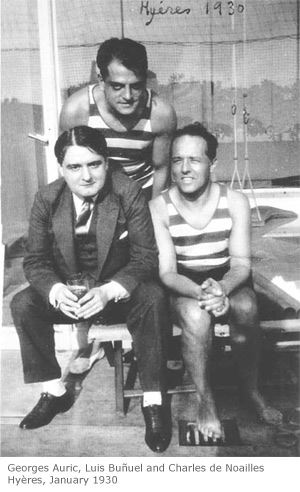 Even though other patrons took an interest in avant-garde cinema, it would seem that Charles and Marie-Laure's investment in this art form was beyond compare. Even though other patrons took an interest in avant-garde cinema, it would seem that Charles and Marie-Laure's investment in this art form was beyond compare.
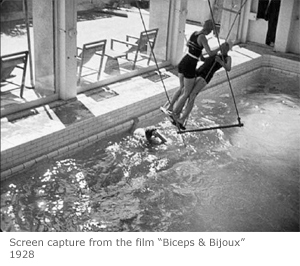 At the beginning of 1928, they were to commission a film by Jacques Manuel called Biceps & Bijoux (Biceps & Jewellery) in which, surrounded by their friends on holiday, they amuse themselves by performing a more or less improvised scenario. Strictly intended for private viewing and despite its formal awkwardness, this film offers a unique account of their lives. At the beginning of 1928, they were to commission a film by Jacques Manuel called Biceps & Bijoux (Biceps & Jewellery) in which, surrounded by their friends on holiday, they amuse themselves by performing a more or less improvised scenario. Strictly intended for private viewing and despite its formal awkwardness, this film offers a unique account of their lives.
In November of 1928, Man Ray was commissioned to direct an entirely more ambitious film. Les Mystères du Château de Dé (The Mysteries of the Château of Dice) staged a bold relationship between the architecture and a ceaselessly moving camera. The film was screened in June of 1929 at the Studio des Ursulines.
They met Jean Lods and Boris Kaufman as a result of their belonging to one of the first film clubs, Les Amis de Spartacus (The Friends of Spartacus). Consequently, the viscount was to join with Étienne de Beaumont in financing their first films, Vingt-quatre heures en trente minutes (Twenty-four hours in thirty minutes, 1928) and Champs-Élysées (1929). These films are now lost, but one may surmise that they were directed in a similar vein to the concepts of Cine Eye by Dziga Vertov, Kaufman's brother.
Despite not having commissioned Salvador Dali and Luis Buñuel's film Un Chien Andalou (An Andalusian Dog), they were key to its success by screening it in their own private cinema (the first in France) which they had installed in their private residence. It was also screened at the Théâtre du Vieux-Colombier, alongside the other films which had benefited from the viscount's influence.
Charles and Marie-Laure de Noailles gave Buñuel carte blanche for his second film, L'Âge d’or (Age of Gold), whose screenplay was completed at the villa in Hyères during the winter of 1930. The shoot was to take place at the same time as that of Jean Cocteau's début film, Le Sang d'un Poète (The Blood of a Poet), which was also financed by the couple and who had now become genuine "producers".
However, in 1931, following the public release of l'Âge d’Or, a shameful campaign resulted in the film being removed from distribution for half a century; this scandal resulted in a sudden end to their patronage of cinema. Cocteau's film, on the other hand, was hailed for its visual and poetic inventiveness when it was screened in December of 1931.
At the end of the 1960s, Marie-Laure de Noailles encouraged the actor, Pierre Clémenti, to start directing his own films which, through their succession of images and through their montage, were not entirely without recalling the lost works of Lods and Kaufman, the Surrealist's collages, or even the scrapbooks created by the viscountess herself. |
|
 |
 |
 |
|
 |
|
| Music, dance and events |
 |
|
 |
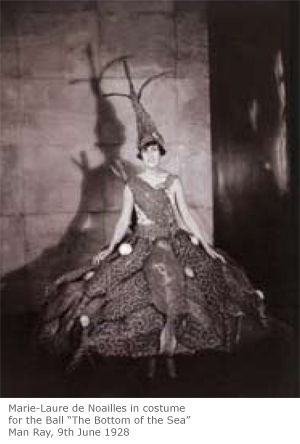 During the Interwar years, Charles and Marie-Laure de Noailles organised themed balls. Many of these soirées offered an opportunity for the commissioning of new works from artists, as well as musicians and dancers, in order to promote their talents. One such example was the ballet, Aubade, commissioned from Francis Poulenc for the Bal des Matières (Materials Ball), and performed at their home on the place des Etats-Unis, in June of 1929, before being reprised at the Théâtre des Champs- Elysées the following year. They also commissioned George Auric to compose his first cinematic soundtrack for Cocteau's debut film; he was subsequently to write in excess of one hundred more. During the Interwar years, Charles and Marie-Laure de Noailles organised themed balls. Many of these soirées offered an opportunity for the commissioning of new works from artists, as well as musicians and dancers, in order to promote their talents. One such example was the ballet, Aubade, commissioned from Francis Poulenc for the Bal des Matières (Materials Ball), and performed at their home on the place des Etats-Unis, in June of 1929, before being reprised at the Théâtre des Champs- Elysées the following year. They also commissioned George Auric to compose his first cinematic soundtrack for Cocteau's debut film; he was subsequently to write in excess of one hundred more.
In 1931, the viscount and his wife participated in the creation of the La Sérénade group and concert series, founded by Yvonne de Casa-Fuerte. Through this series – under the artistic direction of the conductor Roger Desormière – they contributed in both the production and distribution of works. Thus, the following year, a concert was given in April of 1932 at Hyères, for five works they had specially commissioned. In December of the same year, they financed the German composer Kurt Weill's visit to Paris, along with his musicians for the Parisian premières of two works written with Brecht, Aufstieg und Fall der Stadt Mahagonny (Rise and Fall of the City of Mahagonny) and Der Jasager (The Affirmer), they also provided him with accommodation, during his exile, in 1933.
Charles and Marie-Laure de Noailles, without asking for anything in return, were to provide Markevitch and Sauguet with the regular financial support they required for the completion of important works such as: the symphonic cantata Le Paradis Perdu (Paradise Lost) for the former, written in London, in 1935, and the opera la Chartreuse de Parme (The Charterhouse of Parma) for the latter, completed in 1936. Darius Milhaud was also to receive a commission for a cantata, for the opening of the Musée de l'Homme (Museum of Man), in 1937.
Though Marie-Laure de Noailles keenly followed the career of her friend, the dancer Serge Lifar, it was after making the acquaintance of Boris Kochno that she was to offer her support to some of the great choreographic projects of that time: the Ballet Russe de Monte Carlo, under the leadership of Massine, Edward James's Les Ballets 1933, and Roland Petit's Ballets des Champs-Élysées. Over the course of her life, Marie-Laure de Noailles also surrounded herself with the friendship of numerous, internationally renowned performers, such as: the pianists Jacques Février and Arthur Rubinstein, the cellist Maurice Gendron, the flautist Jean-Pierre Rampal, and the clarinettist Robert Veyron-Lacroix. |
|
 |
 |
 |
 |
 |
 |
 |
VIDEO |
 |
|
|
 |
|
 |
 |
 |
| |
 |
|
 |
 |
 |
 |
LOCALIZZAZIONE |
 |
|
|
 |
|
 |
 |
 |

|
 |

|
Continente |
|
 |
|
Nazione |
|
 |
|
Regione |
|
 |
|
Dipartimento |
|
 |
|
Arrondissement |
|
 |
|
Cantone |
|
 |
|
Città |
|
 |
|
Indirizzo |
|
 |
|
|
|
 |
|
Telefono |
|
 |
|
Sito web |
|
 |
|
E-mail |
|
 |
contact@villanoailles-hyeres.com |
|
 |
 |
 |
 |
MAPPA |
 |
|
|
 |
|
 |
 |
 |
| |
 |
|
 |
 |
 |
 |
|
TIPOLOGIA |
 |
|
|
 |
|
 |
 |
 |
|
|
 |
ARCHITETTURA | Edifici per attivita' culturali
Centri culturali e centri sociali
Edifici residenziali
Abitazioni unifamiliari, bifamiliari e ville
| |
 |
 |
 |
 |
CRONOLOGIA |
 |
|
|
 |
|
 |
 |
 |
Progetto |
 |
|
 |
| 
 |
1924
|
|
Realizzazione |
 |
|
 |
| 
 |
1924 - 1933 |
|
 |
 |
 |
 |
L'OPERA NEL CINEMA |
 |
|
|
 |
|
 |
 |
 |
| Titolo |
 |
|
 |
|
| Regia |
 |
|
 |
|
| Nazionalità |
 |
|
 |
|
| Anno di produzione |
 |
|
 |
|
| Interpreti |
 |
|
 |
| Pierre Prévert, Gaston Monot, Max Ernst |
|
| Ruolo dell'edificio |
 |
|
 |
|
 |
 |
 |
|
 |
|
| Titolo |
 |
|
 |
|
| Regia |
 |
|
 |
|
| Nazionalità |
 |
|
 |
|
| Anno di produzione |
 |
|
 |
|
| Interpreti |
 |
|
 |
| Enrique Rivero, Elizabeth Lee Miller |
|
| Ruolo dell'edificio |
 |
|
 |
|
 |
 |
 |
|
 |
|
| Titolo |
 |
|
 |
| Les Mystères du château de Dé |
|
| Regia |
 |
|
 |
|
| Nazionalità |
 |
|
 |
|
| Anno di produzione |
 |
|
 |
|
| Interpreti |
 |
|
 |
| Georges Auric, Le Comte de Beaumont, Charles de Noailles, Marie-Laure de Noailles |
|
| Ruolo dell'edificio |
 |
|
 |
|
 |
 |
 |
|
 |
|
| Titolo |
 |
|
 |
|
| Regia |
 |
|
 |
|
| Nazionalità |
 |
|
 |
|
| Anno di produzione |
 |
|
 |
|
| Interpreti |
 |
|
 |
| Charles de Noailles, Marie-Laure de Noailles |
|
| Ruolo dell'edificio |
 |
|
 |
|
 |
 |
 |
 |
 |
 |
 |
RIFERIMENTI BIBLIOGRAFICI |
 |
|
|
 |
|
 |
 |
 |
|
 |
| Francesco Dal Co, "The Health of Nations", Casabella 772-773, dicembre 2008-gennaio 2009/december 2008-january 2009 [Sport per tutti], "Editoriale" pp. 3-5 |
|
|
| Richard Klein, Hector Guimard. Robert Mallet-Stevens. Villas modernes, Edition Scérén, 2005, pp. 32-39 |
|
|
| Laurence Benaïm, Marie Laure de Noailles. La vicomtesse du bizare, Grasset, Paris 2001 |
|
|
| Briolle Cécile, Fuzibet Agnès, Monnier Gérard, Mallet-Stevens. La villa Noailles, Parenthèses, Marseille 1990 |
|
 |
 |
 |
 |
 |
 |
 |
AGGIUNTE E DIGRESSIONI |
 |
|
|
 |
|
 |
 |
 |
| |
 |
Sage, August in Paris [Sage], Ambroise Willaume, Sony Atv Music Publishing, France 2016
Video directed by Thibaut Grevet |
|
|
|
Archimode. Six architectures for fashion
Zaha Hadid, Rem Koolhaas Christian de Portzamparc Ciguë, Diplomates |
 The villa Noailles art centre is a good example of ”archimode”, a fusion between architecture and fashion. Since the 1920s, Charles and Marie-Laure de Noailles’ patronage and above all their curiosity animated this site of encounters and artistic creation. Designed by Robert Mallet-Stevens, the villa was thus filled with an avant-garde atmosphere that is still tangible today: since in 1996 the annual International Festival of Fashion and Photography in Hyères — launched in 1986 — took residence within the villa. In 2015, for its thirtieth anniversary, fashion takes pride of place in the exhibition ”Archimode”, exploring the similarities between the work of fashion designers and architects for whom the subject of the human body is key to all projects. The villa Noailles art centre is a good example of ”archimode”, a fusion between architecture and fashion. Since the 1920s, Charles and Marie-Laure de Noailles’ patronage and above all their curiosity animated this site of encounters and artistic creation. Designed by Robert Mallet-Stevens, the villa was thus filled with an avant-garde atmosphere that is still tangible today: since in 1996 the annual International Festival of Fashion and Photography in Hyères — launched in 1986 — took residence within the villa. In 2015, for its thirtieth anniversary, fashion takes pride of place in the exhibition ”Archimode”, exploring the similarities between the work of fashion designers and architects for whom the subject of the human body is key to all projects.
The projects on exhibition reveal the varied commissions architects meet, often revolving around issues of diffusion and events. From a New York building to a transportable and transformable monolith, from a traditional Japanese shop to the scenography of boutiques, the architects aim to represent the spirit of a fashion house and even, in some cases, to add the finishing touches to a wardrobe through its mise-en-scène. The interaction between architecture and fashion goes far beyond the edifice itself.
Some architectures are intentionally neutral. Hence they remain withdrawn from fashion’s accelerated production rhythms. Others, as is the case with haute couture, are unique made to measure works, ephemeral for the duration of a show or permanently recording a technological and spatial experience.
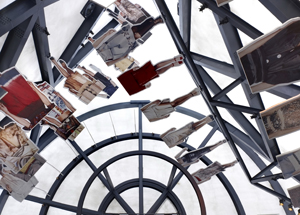 ”Archimode” creates a bridge between well known architecture firms and a new generation of architects who have united conception and production within a single locale. By reinstating architects with a role as constructors, they echo the work methods of the designers with whom they collaborate. ”Archimode” creates a bridge between well known architecture firms and a new generation of architects who have united conception and production within a single locale. By reinstating architects with a role as constructors, they echo the work methods of the designers with whom they collaborate.
Six architectures are presented:
- Mobile Art, Chanel — Zaha Hadid architects
- Prada Transformer — OMA, Rem Koolhaas
- Tour LVMH — Atelier Christian de Portzamparc
- Boutique Isabel Marant — Ciguë
- Boutique Kris Van Assche — Ciguë
- Boutique Damir Doma — Diplomates
The exhibition held many original documents: drawings, plans, research mock up, final mock up, materials given by the architects and the fashion brands. Videos (timelaps, making off...) and a selection of books by the architects.
Lucas Biberson and Guillaume Henry, two young architects design the scenography, using stones from Bormes, a local material from Hyères area.
The Villa Noailles has commissioned the artist Éva Le Roi who draws special illustration for this exhibition.
Exhibition: 22 February / 22 March 2015
» IMAGES |
|
|
Sage, Eyes Closed, Ambroise Willaume, Label GUM, France 2015
Live at Villa Noailles
XXXH Hyères Festival 2015 |
|
|
 |
 |
 |
 |
 |
 |
 |
COMMITTENTE |
 |
|
|
 |
|
 |
 |
 |
| |
 |
| Charles et Marie-Laure de Noailles |
|
 |
 |
 |
 |
DATI
DIMENSIONALI |
 |
|
|
 |
|
 |
 |
 |
| Superficie |
 |
|
 |
|
 |
 |
 |
 |
STAFF |
 |
|
|
 |
|
 |
 |
 |
|
 |
|
Direzione lavori |
 |
|
 |
 |
 |
 |
ANNOTAZIONI |
 |
|
|
 |
|
 |
 |
 |
| |
 |
La villa fu costruita sulle rovine del castello medievale di Saint-Bernard.
Nel 1973 è stata ristrutturata dal Comune di Hyères e trasformata in centro culturale per incontri di arte e architettura. |
|
 |
 |
 |
 |
CREDITS |
 |
|
|
 |
|
 |
 |
 |
| |
 |
Text edited by Villa Noailles
Images courtesy of Villa Noailles
|
|
 |
  |
 |
|
|